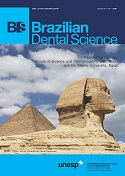Application of Bio-Oss in tissue regenerative treatment prior to implant installation: literature review
DOI:
https://doi.org/10.14295/bds.2019.v22i2.1691Abstract
Objetivo: Bio-Oss is a xenogene bone graft in which all organic components are removed while retaining their natural mineral architecture. Therefore, the aim of this study was to evaluate, through a literature review, the benefits of using Bio-Oss for tissue regenerative treatment prior to implant placement. Material and Methods: a search was performed in Pubmed (Medline) in order to identify articles published in English between January 1, 2000 and June 31, 2018, where the Bio-Oss graft was used prior to implantation of implants in humans. A total of 40 studies were selected for detailed analysis. From this analysis, 18 articles were identified for inclusion in this review. Results: the articles analyzed in the review showed several beneficial effects of this xenograft, such as: positive osteoconductive properties, recovery of bone heights at sites with severe atrophies, slow xenograft reabsorption suggesting long term stability, survival rates and success of implants placed in grafted sites ranging from 91 to 100% in several studies. Conclusion: the use of bio-oss as a bone substitute is a viable alternative in the placement before dental implants, being used in clinical practice and with proved efficacy in several studies, due to its similarity with the bone and its high level of osteoconductivity.
Keywords
Bio-Oss; Bone Graft; Implants.
Downloads
Downloads
Published
How to Cite
Issue
Section
License
Brazilian Dental Science uses the Creative Commons (CC-BY 4.0) license, thus preserving the integrity of articles in an open access environment. The journal allows the author to retain publishing rights without restrictions.
=================




























